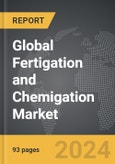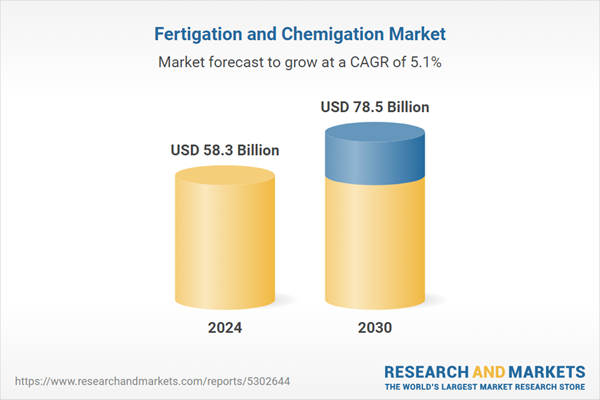Global Fertigation and Chemigation Market - Key Trends & Drivers Summarized
What Is Driving Demand for Fertigation and Chemigation in Agriculture?
The demand for fertigation and chemigation is rising as farmers seek efficient, precise, and sustainable ways to apply fertilizers, pesticides, and other crop inputs. Fertigation, the process of delivering fertilizers through irrigation systems, and chemigation, which involves applying chemicals such as pesticides or fungicides through irrigation, allow for targeted application directly to the plant root zone. These practices enhance nutrient uptake, reduce input waste, and improve crop yield and quality, making them attractive options in modern agriculture. With rising costs of fertilizers and agrochemicals, producers are turning to fertigation and chemigation systems to maximize resource efficiency and cost-effectiveness, particularly in regions with water scarcity where precise water and nutrient management is essential.Fertigation and chemigation systems are especially valuable in high-value crops like fruits, vegetables, and nuts, as well as in controlled environments such as greenhouses, where precision in nutrient and chemical delivery is critical. As global food demand increases, farmers are prioritizing methods that optimize crop yield and quality. This trend is prevalent in regions like North America, Europe, and Asia-Pacific, where the adoption of advanced farming technologies supports efficient production. By integrating nutrient and chemical applications with irrigation, farmers are able to achieve better growth performance and quality, making fertigation and chemigation essential for high-efficiency agriculture.
How Are Technological Advancements Impacting Fertigation and Chemigation Systems?
Technological advancements in automation, sensor technology, and data analytics are significantly enhancing the precision, efficiency, and user-friendliness of fertigation and chemigation systems. Automated fertigation systems, integrated with smart irrigation controllers, allow for real-time adjustments based on soil moisture, crop needs, and weather conditions, ensuring optimal nutrient and chemical delivery. Sensors and IoT-based monitoring systems provide farmers with accurate data on soil health, moisture levels, and nutrient status, allowing for targeted application and minimizing overuse or underuse of fertilizers and chemicals.Furthermore, advancements in remote control and mobile applications enable farmers to monitor and adjust fertigation and chemigation systems remotely, making management more convenient and responsive to changing field conditions. Modern systems also feature flow control valves and filtration mechanisms that prevent clogging and ensure uniform distribution of nutrients and chemicals across the field. By integrating data analytics and automation, these technologies are making fertigation and chemigation more accessible, efficient, and sustainable. Farmers can now achieve precise applications tailored to specific crop stages, soil types, and environmental conditions, maximizing the benefits of these practices while conserving resources.
What Role Do Environmental and Regulatory Concerns Play in Shaping the Fertigation and Chemigation Market?
Environmental and regulatory concerns are major drivers in the fertigation and chemigation market as governments and consumers push for sustainable farming practices that minimize chemical runoff and water pollution. Traditional methods of applying fertilizers and pesticides often result in nutrient leaching and chemical runoff, leading to contamination of soil and water resources. Fertigation and chemigation offer a more controlled application, reducing the risk of environmental contamination by delivering nutrients and chemicals directly to the root zone. This targeted approach supports sustainable practices, as it minimizes chemical use and conserves water, aligning with regulatory requirements and consumer demand for eco-friendly farming.Regulations in regions like the European Union and North America are increasingly stringent regarding chemical use and environmental protection in agriculture. Compliance with these regulations is encouraging farmers to adopt fertigation and chemigation, as these systems help meet environmental standards while ensuring crop productivity. In addition, as consumers prioritize sustainably sourced products, fertigation and chemigation systems offer a method of responsible farming that reduces the environmental impact of crop inputs. The focus on sustainable practices is driving the adoption of these systems in both developed and developing agricultural regions, as they provide a viable solution for improving productivity in an environmentally responsible manner.
What Factors Are Driving Growth in the Fertigation and Chemigation Market?
The growth in the fertigation and chemigation market is driven by the need for efficient resource use, the adoption of precision farming technologies, regulatory compliance, and sustainability goals. As water and fertilizer costs rise, farmers are increasingly investing in fertigation and chemigation systems to optimize input use, improve crop yields, and reduce costs. Technological advancements in automated and sensor-integrated systems are making it easier for farmers to apply nutrients and chemicals precisely, enhancing productivity and reducing waste. The trend toward precision agriculture, with a focus on data-driven decision-making, is accelerating the adoption of fertigation and chemigation as part of comprehensive nutrient management strategies.Environmental and regulatory pressures are also boosting the market, as fertigation and chemigation systems align with sustainability standards by minimizing nutrient runoff, reducing chemical usage, and conserving water. The growing consumer demand for sustainably produced crops further supports this trend, as farmers increasingly adopt practices that align with eco-friendly expectations. Together, these factors - cost efficiency, technological innovation, regulatory support, and sustainability objectives - are propelling robust growth in the fertigation and chemigation market, positioning these systems as key components of modern, responsible agricultural practices that support high yields and environmental conservation.
Report Scope
The report analyzes the Fertigation and Chemigation market, presented in terms of market value (US$ Thousand). The analysis covers the key segments and geographic regions outlined below.- Segments: Irrigation System (Drip, Sprinkler); Input Type (Fertilizers, Insecticides, Fungicides, Herbicides, Other Input Types); Application (Agriculture Irrigation, Landscape Irrigation, Greenhouse Irrigation, Other Applications).
- Geographic Regions/Countries:World; United States; Canada; Japan; China; Europe (France; Germany; Italy; United Kingdom; Spain; Russia; and Rest of Europe); Asia-Pacific (Australia; India; South Korea; and Rest of Asia-Pacific); Latin America (Argentina; Brazil; Mexico; and Rest of Latin America); Middle East (Iran; Israel; Saudi Arabia; United Arab Emirates; and Rest of Middle East); and Africa.
Key Insights:
- Market Growth: Understand the significant growth trajectory of the Drip Irrigation System segment, which is expected to reach US$51.9 Billion by 2030 with a CAGR of a 5.4%. The Sprinkler Irrigation System segment is also set to grow at 4.5% CAGR over the analysis period.
- Regional Analysis: Gain insights into the U.S. market, valued at $15.3 Billion in 2024, and China, forecasted to grow at an impressive 7.9% CAGR to reach $17.6 Billion by 2030. Discover growth trends in other key regions, including Japan, Canada, Germany, and the Asia-Pacific.
Why You Should Buy This Report:
- Detailed Market Analysis: Access a thorough analysis of the Global Fertigation and Chemigation Market, covering all major geographic regions and market segments.
- Competitive Insights: Get an overview of the competitive landscape, including the market presence of major players across different geographies.
- Future Trends and Drivers: Understand the key trends and drivers shaping the future of the Global Fertigation and Chemigation Market.
- Actionable Insights: Benefit from actionable insights that can help you identify new revenue opportunities and make strategic business decisions.
Key Questions Answered:
- How is the Global Fertigation and Chemigation Market expected to evolve by 2030?
- What are the main drivers and restraints affecting the market?
- Which market segments will grow the most over the forecast period?
- How will market shares for different regions and segments change by 2030?
- Who are the leading players in the market, and what are their prospects?
Report Features:
- Comprehensive Market Data: Independent analysis of annual sales and market forecasts in US$ Million from 2024 to 2030.
- In-Depth Regional Analysis: Detailed insights into key markets, including the U.S., China, Japan, Canada, Europe, Asia-Pacific, Latin America, Middle East, and Africa.
- Company Profiles: Coverage of players such as EPC Industrie Limited, Jain Irrigation Systems Limited, Lindsay Corporation, Nelson Irrigation Corporation, Netafim and more.
- Complimentary Updates: Receive free report updates for one year to keep you informed of the latest market developments.
Some of the 37 companies featured in this Fertigation and Chemigation market report include:
- EPC Industrie Limited
- Jain Irrigation Systems Limited
- Lindsay Corporation
- Nelson Irrigation Corporation
- Netafim
- Rain Bird Corporation
- Rivulis Irrigation
- The Toro Company
- T-L Irrigation Co.
- Valmont Industries, In.
This edition integrates the latest global trade and economic shifts into comprehensive market analysis. Key updates include:
- Tariff and Trade Impact: Insights into global tariff negotiations across 180+ countries, with analysis of supply chain turbulence, sourcing disruptions, and geographic realignment. Special focus on 2025 as a pivotal year for trade tensions, including updated perspectives on the Trump-era tariffs.
- Adjusted Forecasts and Analytics: Revised global and regional market forecasts through 2030, incorporating tariff effects, economic uncertainty, and structural changes in globalization. Includes historical analysis from 2015 to 2023.
- Strategic Market Dynamics: Evaluation of revised market prospects, regional outlooks, and key economic indicators such as population and urbanization trends.
- Innovation & Technology Trends: Latest developments in product and process innovation, emerging technologies, and key industry drivers shaping the competitive landscape.
- Competitive Intelligence: Updated global market share estimates for 2025, competitive positioning of major players (Strong/Active/Niche/Trivial), and refined focus on leading global brands and core players.
- Expert Insight & Commentary: Strategic analysis from economists, trade experts, and domain specialists to contextualize market shifts and identify emerging opportunities.
Table of Contents
Companies Mentioned (Partial List)
A selection of companies mentioned in this report includes, but is not limited to:
- EPC Industrie Limited
- Jain Irrigation Systems Limited
- Lindsay Corporation
- Nelson Irrigation Corporation
- Netafim
- Rain Bird Corporation
- Rivulis Irrigation
- The Toro Company
- T-L Irrigation Co.
- Valmont Industries, In.
Table Information
| Report Attribute | Details |
|---|---|
| No. of Pages | 376 |
| Published | December 2025 |
| Forecast Period | 2024 - 2030 |
| Estimated Market Value ( USD | $ 58.3 Billion |
| Forecasted Market Value ( USD | $ 78.5 Billion |
| Compound Annual Growth Rate | 5.1% |
| Regions Covered | Global |









